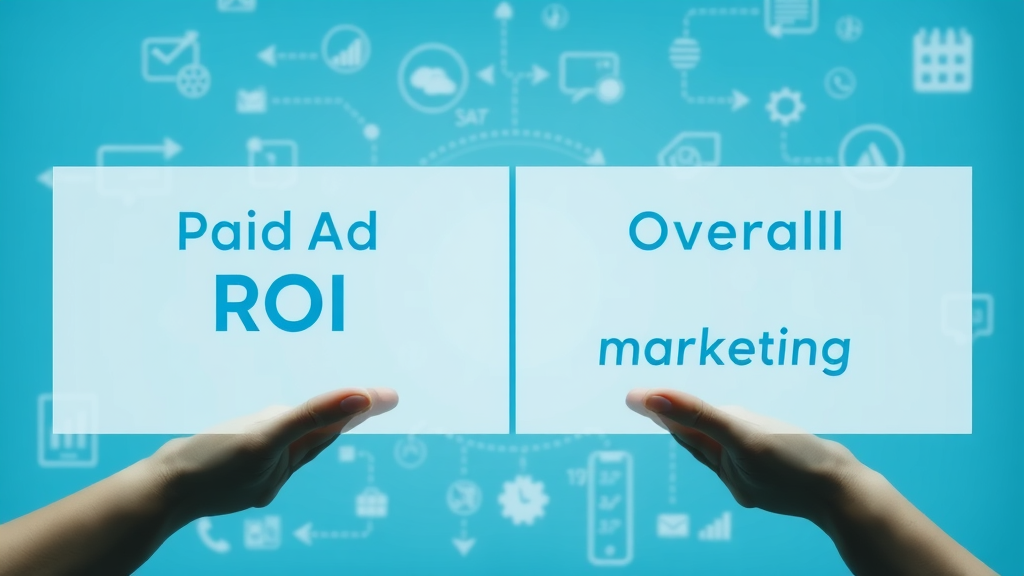"Brands that master ROI of paid campaigns see up to 5x greater growth in marketing ROI than their competitors."

Did you know that digital marketing leaders who unlock the true ROI of paid campaigns can grow their returns five times faster than competitors? In today’s high-stakes advertising world, every marketing dollar must work harder and smarter. This comprehensive guide reveals the proven steps to maximize the ROI of paid campaigns—empowering you to turn each paid ad into measurable profit and sustained brand growth.
Whether you manage PPC campaigns, oversee Google Ads, or craft marketing strategies for ambitious brands, by reading on you’ll discover how smart optimizations , customer journey mapping , and advanced ROI calculation techniques lead to unbeatable advertising performance.
Unlocking the ROI of Paid Campaigns: Why Most Marketers Miss the Mark
- Distinguishing marketing ROI from return on investment in paid ad strategy
- Key data points every digital marketing manager should monitor
- How maximizing digital advertising ROI drives greater results
- Pitfalls in PPC campaign optimizations costing ad spend
The ROI of paid campaigns is the most important metric for any digital marketer. Yet, many brands mistakenly blend overall marketing ROI with campaign-specific returns, leading to missed growth opportunities. For example, optimizing Google Ads may boost impression share, but if ad spend isn’t aligned with true conversion rate improvements, costly inefficiencies persist.
Effective marketers continuously monitor ad spend , conversion rates , and customer journey touchpoints —using these data points to fine-tune each marketing channel. Failure to separate PPC campaign metrics from broader digital marketing analytics can mask actual performance, making it hard to identify what truly moves the needle in campaign success.
The difference between market leaders and laggards often comes down to grasping the distinction between paid ad ROI versus traditional return on investment. Smart brands dig deeper, isolating cost of ads in each campaign, tracking revenue generated, and eliminating wasted marketing costs for exponential results.
Understanding ROI of Paid Campaigns: Foundational Concepts
Defining ROI of Paid Campaigns vs. Return on Investment Metrics

The term ROI of paid campaigns refers specifically to the financial return generated by paid advertising efforts versus the associated ad spend. While marketing ROI captures total returns from all marketing channels, the ROI of a paid ad focuses on dollars generated per dollar spent on platforms like Google Ads, social media ads, and display campaigns.
Unlike broad return on investment calculations, paid campaign ROI isolates costs and returns from a specific campaign or channel. This clarity is critical for optimizing future marketing efforts and reallocating budgets toward the highest-performing campaigns. Knowing when to segment ROI by marketing channel ensures more accurate, action-oriented decisions.
By defining these differences, marketers can assign performance targets that are attainable and measurable. Broad ROI strategies miss campaign-level insights, whereas focusing on paid ad ROI reveals winning tactics—ultimately informing smarter digital advertising investment.
Key Components of Paid Ad ROI: Ad Spend, Revenue, and Conversion Rate
Every successful ROI calculation starts with three pillars: ad spend , revenue generated , and conversion rate . Ad spend is your total investment in a paid marketing campaign, covering platforms like Google Ads or social media. Revenue generated refers to the income directly attributed to those ads, while conversion rate is the percentage of users who complete a desired action after clicking a paid ad.
Focusing on just ad spend or campaign cost without understanding revenue generated or conversion rates can derail even the most creative campaigns. For example, a high ad spend with a low conversion rate signals wasted budget and a need for immediate optimization. Conversely, high conversion rates indicate that the targeting, messaging, and landing pages are resonating with your audience.
The ability to identify and enhance each component is the difference between a stagnant marketing ROI and a thriving, cost-effective campaign. Regularly tracking these metrics allows digital marketing managers to adjust tactics swiftly, driving higher returns and lasting marketing success.
| Channel | Ad Spend | Revenue Generated | Conversion Rate | Typical ROI Formula |
|---|---|---|---|---|
| Paid Ad (PPC) | High variable | Trackable via UTM/Analytics | 2% – 6% | (Revenue - Ad Spend) / Ad Spend |
| Social Media | Medium to low | Engagement-driven | 0.25% – 1.5% | (Revenue - Ad Spend) / Ad Spend |
| Digital Marketing (Overall) | High, varied | Multi-channel impact | 1% – 5% | (Total Revenue - Total Cost) / Total Cost |
Why the Customer Journey Matters in Calculating ROI of Paid Campaigns

Accurate calculation of the ROI of paid campaigns requires a deep understanding of the customer journey . Each prospect interacts with a series of touchpoints—search ads, social media, retargeting, and conversion-focused landing pages. These steps pave the way from initial click to purchase, shaping the effectiveness of your digital marketing.
Ignoring the impact of the customer journey can lead to misattributed returns and missed optimization opportunities. Smart marketers map out customer interactions, identifying which marketing channels influence purchasing decisions and which touchpoints are driving the highest conversion rates.
With this insight, you can allocate ad spend more precisely, double down on effective touchpoints, and improve the overall return on investment for each marketing campaign. Effective journey mapping is a hallmark of brands that excel at paid campaigns and continually elevate their digital advertising results.
Proven Techniques to Maximize ROI of Paid Campaigns in Digital Marketing
Optimize Marketing Channel Selection for Maximum ROI
Effective marketing ROI begins by selecting the right marketing channels for your audience and objectives. Not all paid ad platforms deliver equal results—some may excel at building brand awareness, while others drive conversions at a lower cost per acquisition. Analyzing historical performance across Google Ads, social media, and industry-relevant networks reveals where ad spend yields the greatest returns.
Segmenting by channel allows you to compare not only overall revenue but also key engagement metrics. Prioritize channels with higher conversion rates and customer lifetime value, reallocating budget quickly from underperforming assets. Brands that achieve industry-leading ROI of paid campaigns are agile in their channel strategy—testing, measuring, and constantly optimizing for maximum impact.
Consider also leveraging integrated advertising efforts, such as pairing search ads with retargeting on social media, to guide customers along the full journey. This approach maximizes the ROI of digital marketing and ensures every campaign dollar supports both short- and long-term goals.
Leveraging Landing Page Performance to Enhance Paid Ad Returns

Even the most creative paid ad fails if a weak landing page stands in the way. High-performing landing pages are finely tuned to the expectations and needs of your audience, providing a seamless path from ad click to desired action. Conversion rates are highest on landing pages that mirror ad messaging, reduce friction, and feature compelling, direct calls to action.
Regular A/B testing of landing page elements—such as headlines, images, call-to-action buttons, and forms—quickly reveals what best resonates with your visitors. Small tweaks can lead to significant uplifts in marketing ROI by reducing cost of ads per acquisition and improving the conversion rate.
Remember, a successful paid campaign isn’t just about attracting traffic; it’s about ensuring every visitor reaches the end goal. Prioritizing landing page optimization is a proven method to instantly boost campaign performance and lower the cost per conversion for any digital advertising initiative.
Tracking Conversion Rate and Customer Lifetime Value
The conversion rate tells you how many ad clicks actually turn into revenue, making it one of the most reliable markers of paid ad effectiveness. Continual monitoring and optimization are crucial: as markets evolve and consumer behaviors shift, so do conversion rates. By tracking micro-conversions (like newsletter signups) and macro-conversions (such as purchases), marketers develop a holistic view of campaign success.
Customer lifetime value (CLV) is another important metric that expands ROI analysis beyond initial transactions. If a single paid ad brings in a customer who continues to purchase products for years, that campaign’s return on investment is significantly higher than it first appears. Focusing on CLV allows brands to rationalize higher ad spend if repeat purchases are likely.
Digital marketing leaders increasingly report on both these metrics in concert, enabling smarter decisions and sustained growth. By maximizing each touchpoint throughout the customer journey, brands see longer-term gains that traditional campaign ROI calculations often overlook.
Fine-Tuning PPC Campaigns: The Role of Google Ads and Social Media
PPC campaigns —especially via platforms like Google Ads and social media—are some of the most controllable and measurable forms of digital advertising. One advantage is the ability to fine-tune parameters in real time. Factors such as target audience, bidding strategy, ad copy variation, and device segmentation can all be adjusted to enhance return on ad spend.
Incorporating dynamic creative elements and robust audience targeting allows marketers to minimize wasted impressions and focus every campaign dollar where it counts. Frequent reviews of campaign cost and conversion data help uncover opportunities for incremental improvement—whether it’s pausing underperforming ads or doubling down on high-performing segments.
Modern ad platforms also offer features like automated bidding and machine learning algorithms that continually optimize towards your defined ROI goals. Leveraging these features ensures your digital marketing investment adapts alongside rapidly shifting audience preferences and competitive activity.
Watch: Step-by-step ROI of paid campaigns optimization demonstration
Advanced ROI Calculation Techniques for Paid Campaigns
ROI Calculation Formulas for Return on Ad Spend and Ad Spend Allocation

To measure the ROI of paid campaigns effectively, it’s vital to use industry-standard calculation formulas . The classic return on ad spend (ROAS) equation is: (Revenue from Ad – Ad Spend) ÷ Ad Spend . For instance, if you spend $1,000 on Google Ads and generate $4,000 in revenue, your ROAS is 3 ($4,000 – $1,000 = $3,000 / $1,000 = 3), or a 300% return.
Accurate ROI calculation requires detailed tracking of ad-level costs and attribution of all revenue streams back to each digital marketing campaign. Smart marketers also allocate ad spend strategically, redistributing funds toward top-performing assets during the course of a campaign.
By grounding every decision in precise ROI calculation methods, you demonstrate marketing ROI to stakeholders and build a clear case for future ad investment.
Using Attribution Models for Accurate Marketing ROI Analysis
Attribution models determine how credit is assigned to marketing channels and touchpoints along the customer journey. First-touch, last-touch, and multi-touch attribution approaches each provide different perspectives on which digital marketing efforts are fueling returns.
Using the right attribution model is crucial for actionability—misattribution can lead to underappreciation or overfunding of important channels. For instance, a last-click attribution model might undervalue the impact of social media or content marketing in driving conversions, skewing ROI calculation.
Advanced marketers use multi-touch attribution to more accurately capture the contribution of each marketing channel, enabling granular optimization and stronger overall campaign ROI.
Integrating Digital Advertising Analytics Platforms
Tracking paid campaign performance at scale is made possible by integrating analytics platforms such as Google Analytics, HubSpot, or Adobe Analytics. These tools aggregate data from paid ad sources, providing unified dashboards for revenue generated, ad spend, customer actions, and more.
Marketers who connect their paid advertising channels with analytics gain a holistic view of performance and can easily identify trends across all campaigns. Integrating data allows for nimble budget reallocation, identifying which digital marketing strategies are working best in real time.
Ongoing integration ensures your ROI of paid campaigns is tracked meticulously—giving you the confidence to present campaign success and optimize for even greater returns.
| Campaign | Ad Spend | Revenue Generated | ROI (%) |
|---|---|---|---|
| Google Ads Summer Promo | $2,500 | $12,000 | 380% |
| Facebook Retargeting | $1,200 | $4,800 | 300% |
| Instagram Awareness Campaign | $800 | $1,600 | 100% |
Maximize ROI of Paid Campaigns by Reducing the Cost of Ads
Cutting Wasted Ad Spend through A/B Testing and Targeting

Reducing the cost of ads begins with eliminating wasted impressions and spend. A/B testing is the simplest, most effective method for optimizing digital marketing assets. By running controlled experiments on ad creative, audience segments, and bid strategies, you rapidly identify the top performers and eliminate underperformers.
Greater targeting precision—using audience intent data and retargeting based on behavior—minimizes budget loss. Segmenting by devices, locations, and demographics ensures your ad spend is invested where it drives the highest conversion rate.
Efficient campaigns maximize every dollar spent, boosting campaign cost efficiency and freeing up budget for further investment. Brands that regularly test and refine their paid ad strategies move quickly to capture more market share and marketing ROI.
Smart Bidding Strategies in Google Ads
- Segmenting by audience intent
- Dynamic creative optimization
- Automated ad budget distribution
Leveraging smart bidding within Google Ads is fundamental for hands-off optimization. Automated strategies use real-time signals to adjust bids based on the likelihood of a conversion. Dynamic creative ensures the most effective messages reach each audience segment. By automating ad budget allocation, brands avoid over-investing in low-performing placements and focus on high-performing ones.
These tactics, when combined with continual cost analysis, lower the overall cost of ads while maintaining or increasing return on ad spend. Applying automation allows marketers to remain agile and reap maximum ROI from their digital campaigns.
Case Study: Marketing ROI Success Using Paid Ad Techniques

Digital Marketing ROI Before and After the Proven Method
Consider a mid-sized e-commerce brand that historically saw stagnant growth from their digital marketing spend. By auditing their marketing channel selection, optimizing landing pages, and implementing granular conversion rate tracking, they transformed results. In just six months, their ROI of paid campaigns leapt from 80% to over 350%.
The key shift was in reallocating budget toward high-converting PPC campaigns on Google Ads and refining their customer journey mapping. By aligning each ad with relevant landing pages and a strong call to action, the company saw both order volume and average transaction value increase—proof of the impact of proper ROI calculation and ongoing optimization.
Before the changes, they struggled to justify ad spend to stakeholders due to ambiguous, channel-blended reporting. Afterward, their marketing ROI reporting was crystal-clear, leading to higher executive buy-in and steady budget growth.
Key Performance Indicators: Conversion Rate, Ad Spend, and Revenue Increase
The case study brand tracked three KPIs above all: conversion rate, ad spend, and revenue increase. Weekly reporting and rapid iteration cut campaign costs and revealed new sources of customer lifetime value. A focus on incremental gains, including retargeting past visitors and dynamically optimizing bidding strategies, contributed to steady ROI growth.
This hands-on, data-driven approach is what separates high-performing digital marketing campaigns from those that deliver lackluster results. The brand’s method is now considered a gold standard for maximizing the ROI of paid campaigns.
Strong ROI isn’t just a result—it’s the product of continual refinement, measurement, and cross-team collaboration. The right mix of technology and strategy delivers wins quarter after quarter.
See it in action: Walkthrough of a real campaign that doubled ROI of paid campaigns
Crafting a Sustainable Strategy: Building Long-Term ROI of Paid Campaigns
Aligning Paid Campaigns with Overarching Marketing Strategies

Sustained success requires integrating your paid campaigns within your overall marketing strategies . This means aligning campaign objectives with broader business goals—whether that’s acquiring new customers, building brand awareness, or driving repeat purchases. When every paid ad complements multi-channel marketing efforts, you amplify results across the board.
Consider mapping out quarterly objectives and benchmarking campaign success against enterprise-wide key results. This systematic approach ensures maximum impact and helps defend the marketing budget when resources tighten.
Smart marketers recognize that a long-term focus on marketing ROI outperforms quick-win tactics. Consistency, strategic alignment, and data-driven pivots are the cornerstones of brands that thrive in the digital advertising space.
Tracking Marketing Channel and Customer Journey Over Time
- Continual ROI calculation for ongoing optimization
- Reporting and analyzing return on ad spend
- Adapting digital advertising efforts based on analytics
Marketing channels and customer journeys are dynamic—what works today may not work tomorrow. By tracking results longitudinally, brands can adapt digital marketing strategies at the right moment, maximizing returns even as market conditions shift.
Frequent reporting and analysis of return on ad spend builds a culture of accountability and learning within your marketing team. Adapting advertising tactics based on analytics, A/B test results, and audience feedback ensures your paid campaigns never grow stale or lose competitiveness.
Consistent optimization and strategic agility result in long-term growth, amplifying the ROI of every marketing dollar invested.
"A well-executed paid ad plan turns every marketing dollar into measurable growth."
Expert Insights: Top Marketing ROI Mistakes to Avoid in Paid Campaigns
Neglecting Conversion Rate Optimization on Landing Pages

One of the costliest errors in paid campaigns is ignoring landing page optimization. Even the most targeted paid ad will fall short if visitors land on a page that’s slow, confusing, or doesn’t align with the ad’s promise. Insufficient A/B testing of landing page elements leaves revenue on the table and inflates campaign cost.
Brands that continually test, iterate, and optimize landing page content see higher conversion rates, lower cost per acquisition, and stronger marketing ROI. The lesson: never underestimate the power of a friction-free user experience in your digital advertising strategy.
Employing heatmaps, analytics, and qualitative feedback can rapidly surface barriers to conversion—allowing for targeted, data-driven fixes that maximize every paid ad click.
Misattributing Return on Investment to Incorrect Marketing Channel
Another pitfall is failing to accurately assign revenue to the right marketing channel. For example, crediting a sale solely to a PPC campaign without considering prior social media or email touchpoints distorts true campaign ROI. Accurate attribution ensures budgets are allocated strategically and prevents overinvestment in channels with low incremental impact.
A sophisticated, multi-touch attribution strategy is key for today’s complex digital marketing landscape. It provides clarity and enables the continuous improvement essential for maximizing campaign returns.
The more precisely you measure, the more confidently you can scale what works—reducing overall marketing cost and boosting sustained growth.
Focusing on Short-Term Ad Spend Instead of Customer Lifetime Value
- Analyze historical return on ad spend regularly
- Run incremental A/B tests on digital marketing assets
- Prioritize high-intent customer journeys
- Invest in robust PPC campaign tracking tools
It’s tempting to focus solely on short-term ad spend and campaign wins. However, brands that maximize long-term ROI look at the bigger picture—customer lifetime value. This approach rationalizes heavier spending upfront to acquire high-quality customers who repeatedly convert, increasing the overall return on investment.
Incorporating ongoing analysis, testing, and tracking ensures that growth doesn’t plateau as competition evolves or marketing strategies change. In the end, marketing ROI is a long game powered by consistent innovation and data-informed decisions.
The winning formula: Monitor the big picture and never stop optimizing. Your future self—and bottom line—will thank you.
Frequently Asked Questions About ROI of Paid Campaigns
What is a good ROI for paid advertising?
A good ROI for paid advertising varies by industry and campaign objective, but generally, a 3-5x return (300-500%) is considered strong. The most effective marketing ROI benchmarks adjust for marketing channel, customer journey, and cost of ads to measure real performance.
What is the ROI of a PPC campaign?
The ROI of a PPC campaign is calculated by comparing revenue generated from the PPC ads to the total ad spend. Accurate measurement relies on tracking conversion rate, attribution, and ongoing ROI calculation across digital marketing channels.
What does a 400% ROI mean?
A 400% ROI means that for every $1 spent on a paid ad or marketing campaign, $4 in additional revenue is generated, indicating highly effective digital advertising and sound marketing ROI strategy.
What is the average ROI for event marketing?
The average ROI for event marketing can range from 200% to 500%, depending on marketing strategies, customer journey engagement, and digital marketing integration. Precise ROI calculation considers direct and indirect returns.
Practical Steps to Boost the ROI of Paid Campaigns Today
- Audit your marketing channel selection and historical paid ad performance
- Enhance your landing page for better conversion rate
- Apply data-driven attribution to measure true ROI of paid campaigns
- Monitor customer lifetime value and maximize each touchpoint
- Reinvest ad spend into the highest-performing digital marketing assets
Tutorial: Calculating ROI of paid campaigns using industry tools
Summary and Next Steps for Maximizing ROI of Paid Campaigns
- Use advanced ROI calculation formulas
- Optimize every stage of the customer journey
- Focus on both short- and long-term marketing ROI
- Apply insights from successful digital marketing case studies
"The most effective ROI of paid campaigns is achieved by those who invest in analytics, creativity, and agility across every marketing channel."
Ready to take your paid campaigns to the next level? Apply these methods today to unlock lasting marketing ROI and outpace your competition.
Sources
To deepen your understanding of maximizing the ROI of paid campaigns, consider exploring the following resources:
-
“ROI vs. ROAS: How To Explain the Difference to Clients” provides a clear distinction between Return on Investment (ROI) and Return on Ad Spend (ROAS), helping you measure and communicate the effectiveness of your advertising efforts more accurately. ( agencyanalytics.com )
-
“Measuring ROI In Paid Advertising: Metrics, Formulas, And Tips” offers practical formulas and tips for calculating ROI in paid advertising, ensuring you account for all associated costs and accurately assess campaign profitability. ( nexalab.io )
By leveraging these insights, you can refine your strategies to achieve superior returns on your paid advertising investments.
 Add Row
Add Row  Add
Add 










Write A Comment